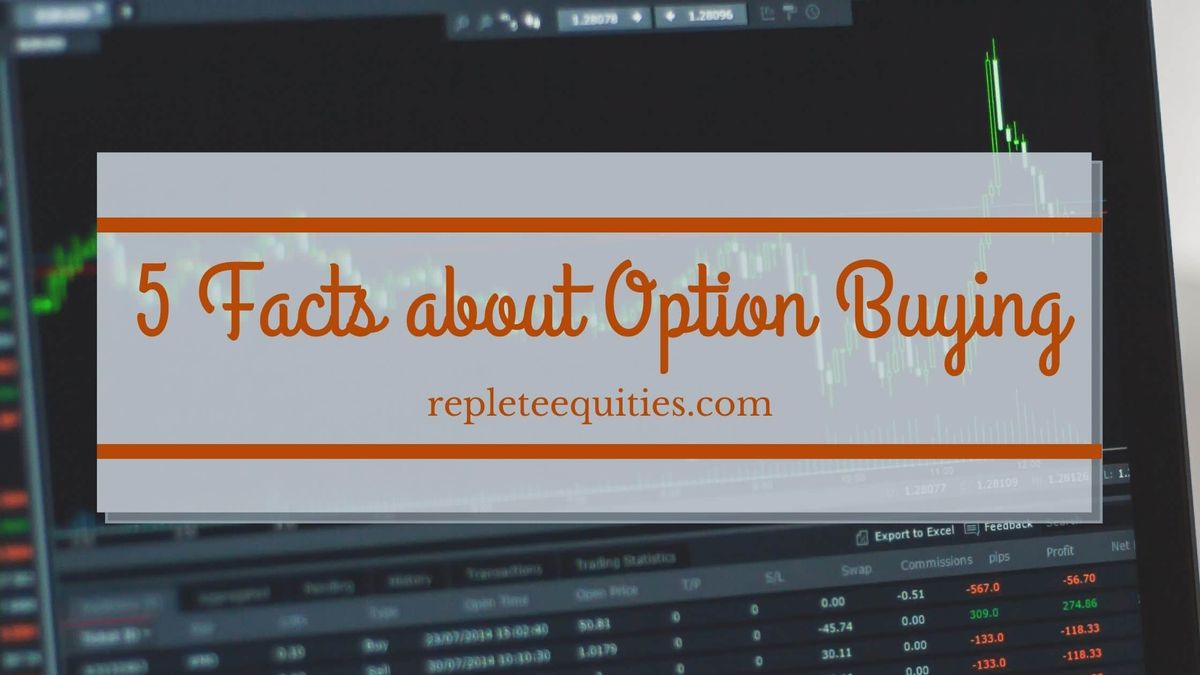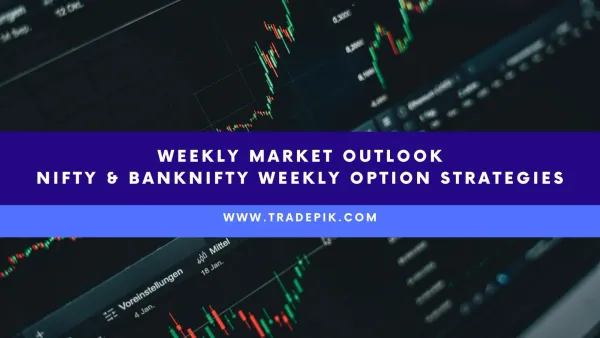5 Facts about Option Buying that helps to avoid the loss

Hello Guys! I hope you are doing good. I have seen mostly novice traders start their options trading with buying options. But unfortunately, end up with huge losses. In today’s article, I’m sharing 5 facts about option buying, every option trader should know before they start their option trading journey.
These 5 facts, only help you to understand options better but will help you to limit your losses so that you can earn from Option buying. So read this post till the end to know these 5 facts about options buying. If you have any queries, you can type in the comment box. I love to solve all your queries.
How options work – The Summary
Options offer an investor better strategic leeway than simply buying or selling stocks. Options are conventionally invested into to protect an investor against portfolio losses and sometimes options also help to increase the profit on a position. Thus, options help to lower the risks taken by an investor in the market.
As explained in the previous article, an option is a financial contract in which the buyer is artificially taking a buy/sell position in a stock or currency or commodity, etc. and a seller takes the opposite side position of buyer i.e., an artificial sell/buy position respectively in the asset classes mentioned.
For example, a buyer may purchase a stock option on the shares of Company X for a strike price of INR 300 considering an expiry date of February 11. Now, the buyer has the right (but is not obligated) to buy the company’s shares at INR 300 per share on or before February 11. After that date, the privilege disappears.
Buying Options may look difficult at first, but it’s easy to understand after learning the key points in the previous article and other such information provided in this article. Options when invested into with a solid plan, prove to be a better investment than stocks or maybe ETFs.
- For a detailed study on options, Read detailed article here: How to trade options?
How to Trade Options?
Options are a type of derivative security. If you buy an options contract, you have the right, but not the obligation to buy or sell an underlying asset on or before the expiration date.
When you buy a call option, you have the right to buy the stock. Similarly, when you buy a put option, you have the right to sell the stock. The call and put options have been explained in the previous article: How to trade Option?
Options can be dealt with in four ways:
- Buy calls
- Sell calls
- Buy puts
- Sell puts
Buying a call option gives an investor a potential long position in the underlying stock, whereas, selling a naked call gives an investor a potential short position in the underlying stock.
On the other hand, buying a put option gives an investor a potential short position in the underlying stock, whereas, selling a naked put gives the investor a potential long position in the underlying stock.
People who buy options are called holders and people who sell options are called writers. The two terms have been differentiated below:
- Call and put holders (buyers) are not obligated to buy or sell. They have the choice to exercise their rights. This limits the risk of buyers of options to only the premium spent.
- Call and put writers (sellers) are obligated to buy or sell if the option expires in the money. It also implies that option sellers have exposure to more risks.
5 Facts about Option Buying
1. Checklist of the Basics – Revisited
Before starting to invest in options, an investor must be completely familiar with the basics such as Greeks, Implied Volatility, Strike Price, and other such important concepts. All these can be found in the article: How to trade Option? Some of these have been summarised below.
Greeks
Option Greeks measure the different factors that affect the price of an option contract. The Key Greeks are Delta, Gamma, Theta, Vega, and Rho.
What can option Greeks do for you?
In options trading, Greeks help an investor to make better decisions about which options to trade, and when to trade them.
- Delta – It means a change in the option’s premium, which is expected to happen with a percentage change in the underlying stock’s/index price
- Gamma – It refers to the rate of change in Delta.
- Theta – It refers to the reduction in an option’s value, which happens as it nears its expiry date
- Vega – It refers to the change resulting from Implied Volatility (IV) on an option’s price
- Rho – It refers to the extent of change that can happen in an option’s premium due to a percentage change in risk-free interest rates.
Implied Volatility
Implied Volatility shows the expected movement of the underlying asset in the future. Implied volatility can be thought of as the market’s expectation of the movement in a security’s price. It can be thought of as a measure of the speed and amount of movement for underlying asset prices. It is commonly expressed using percentages and standard deviations over a specified period.
Implied volatility generally increases in bearish markets, when there is a belief that equity prices will see a decline in the foreseeable time. It decreases when the market is bullish, and investors believe that prices are likely to rise in the foreseeable time.
Strike Price
When you buy a call option, the strike price is the price at which you can buy the underlying stock if you want to use the option. Let’s say, you buy a call option with a strike price of INR 100, you have a right, but no obligation, to buy that stock at INR 100.
It is profitable to do so only if the underlying stock is trading above INR 100. In such cases, the investor can also sell the call for a profit. The profit can be calculated as approximately the difference between the underlying stock price and the strike price. On the other hand, you can exercise your option and buy the stock at INR 100, even if it is trading at INR 150.
2. Understanding Options Pricing
There are two basic components to the premium you pay when buying an option. These have been discussed in this section.
Intrinsic Value
The first component is the intrinsic value. The intrinsic value of an option is the amount of money a buyer would get if they exercised the option immediately. It is calculated as the difference between the strike price and the asset’s current market value when the difference is positive.
For example, suppose an investor buys a call option for Company A with a strike price of INR 300. If the stock is currently valued at INR 370, the option has an intrinsic value of INR 70.
However, if one buys a call option for Company A with a strike price of INR 400 and the current market value is only INR 300, there is no intrinsic value. This is called being out of the money.
Time Value
The options contract may be out of the money but will eventually have value due to a change in the underlying asset’s market price. That is the time value of an options contract. In simple words, it signifies whatever price an investor is willing to pay above the intrinsic value when the investor is in search of striking a profit.
For example, suppose someone buys Company A’s call option with a strike price of INR 300 and the underlying falls from INR 350 to INR 280. The option is now out of the money.
Let’s say an investor buys a call option with a strike price of INR 450, and it had an intrinsic value of INR 100 since the stock was selling at INR 550. Investors might be willing to pay an extra INR 250 to hold a one-year contract because they expect the stock price to rise. That would make the total option premium INR 350 (INR 100 [Intrinsic value] + INR 250 [Time value]).
3. Effect of Implied Volatility on Option Premium
Implied Volatility indicates the expected movement of the underlying asset in the future i.e., for a year. Understanding volatility and its effect help investors to better understand the behavior of options.
Implied volatility is a prediction made by investors, of how much the underlying securities are likely to move in the future. This is the prediction of the volatility of an option’s underlying asset over the lifespan of the option.
When options markets experience a downfall, implied volatility can be generally seen to rise. Similarly, market uptrends usually cause implied volatility to fall. Higher implied volatility is a sign that option price is likely to move a lot in the future.
How Implied Volatility Affects Options
As expectations change, option premiums also change. Implied volatility is highly influenced by the supply and demand of the underlying options. It is also influenced by the market’s expectation of the movement of the share’s price. As the demand for an option will increase, implied volatility will also rise. Premiums of the options that have high levels of implied volatility will also rise.
Similarly, as the demand for an option diminishes, the implied volatility will decrease. The rise and fall of implied volatility determine the importance of time value to the option.
For example, when implied volatility increases, the price of the options is likely to increase. An unexpected change in implied volatility can create huge losses for the investor.
Using Implied Volatility to Your Advantage
A very important way to analyze implied volatility is to thoroughly examine a chart. Many platforms provide ways to chart an underlying option’s average implied volatility such as intradingview.com
Here is a simple strategy. Look at the peaks to determine when implied volatility is relatively high, and similarly look at the troughs to determine when implied volatility is relatively low. This helps to determine when the underlying options are under-priced or overpriced. Implied volatility is likely to move in cycles.
High-volatility periods usually follow low-volatility periods and vice versa. If you can see where the relative highs are, there is likely a future drop in implied volatility. Similarly, if you determine where implied volatility is relatively low, you might forecast a possible rise in implied volatility.
Using relative implied volatility ranges can help an investor to select the best possible trade. When determining a suitable strategy, it is critical in finding a high probability of success.
4. Options Buying is Risk-Free… Is it True?
Humans always have an undying tendency to complicate the easiest of matters. Options Trading is one such subject that has been made so complex that it scares away most of the people who want to learn, invest and make a profit.
Options were originally meant to protect an investor’s portfolio against future events in the markets. Another name for such events is Black Swan events.
Options are considered as the insurance of one’s portfolio and cost and are meant to protect you in case of a decline in value.
Speculative Option Trading:
The real fact is that most of the Options Trades are speculative in their trading practices. Investors take speculative positions as the leverage is very high and profits are also huge. With high profits come high risks and hence the question:
What are the risks associated with Options Trading?
In fact, risks are the same in every market worldwide. Some of the risks which one should be very careful against are:
- Stock Options have volumes in current month contracts. The pricing of next month’s contract might be arbitrary due to a lack of volumes. Thus, the price action should happen quickly within the period for making any profits.
- For Nifty and Nifty Bank contracts current month and next month contracts are quite liquid and thus one gets more time as compared to stock options. The loophole is that due to the longer time available, the volatility is less and thus one is not able to derive the benefit of volatility.
- The market is generally more volatile near to the contract expiry and selling Options close to expiry may cause real harm. Remember, selling options has limited profit but unlimited loss.
- One might lose 100% of the premium paid in case of buying options.
One can indeed gain magnificent profits in case they are right within the contract expiry period but one has to be very careful, even while buying options.
5. Using Greek Delta to Estimate the Probability of Strike
The strike price of an option is the price at which a put or call option can be exercised. The Delta of an option is often used as a proxy for the probability of strike which is also called probability to exercise.
Delta is often used by investors to estimate if the option is likely to make money. This can be understood with a simple example.
Suppose, if the Delta of an option is 0.50, it can be estimated that the option has about 50% probability to make money. Similarly, if Delta is 0.35, the option has about 35% probability to make money.
Usually, OTM (Out-Of-Money) call options have Delta between 0 and 0.5, whereas, OTM put options usually have Delta between 0 and -0.5. ITM (In-the-Money) call options usually have between 0.5 and 1, whereas ITM put options usually have Delta between -0.5 and -1.
This simple example shows that using Delta can usually provide quite useful results approximating nearby probability to exercise.
It is very important to point out that when an investor is taking deep OTM (Out-Of-Money) options, it should be kept in mind that the investor might be paying less amount as the premium, but the option has a low probability to make money.
It should be noted that Delta is not going to be exactly equal to the probability to exercise, and is not as detailed as the actual statistic, but it is a great tool and gives the investor a great comparing scale. Thus, Delta should only be seen and considered as an approximation of the probability of strike.
I hope now you have understood how important these 5 facts about option buying are. If you any query related to these 5 facts about option buying can type in the comment box.
Must Read these Also:
- Unlocking the Secrets to the Most Successful Options StrategyJune 2, 2023
- How to Use Options to Speculate on the Market?May 31, 2023
- Mastering the PCR Ratio: Unlocking the Power of Option TradingMay 25, 2023
- How Effective Trade Management Can Boost Your Options Trading StrategyMarch 16, 2023
Options Strategies – A Mentorship Program
On the 1st of September, We have launched a new mentorship program for Option strategies, in which we’ll discuss how can we deploy these strategies? What rules we should follow before taking a trade? and what should be our adjustments if the script is moving against your direction?
Learn Option strategies with Sachin Sival
DISCLAIMER: – we are not a SEBI research analyst. Views posted in these 5 facts about option buying are only for educational purposes. There is no liability whatsoever for any loss arising from the use of this product or its contents. This product is not a recommendation to buy or sell, but rather a guideline to interpreting specified analysis methods. This information should only be used by investors and traders who are aware of the risk inherent in securities trading.





